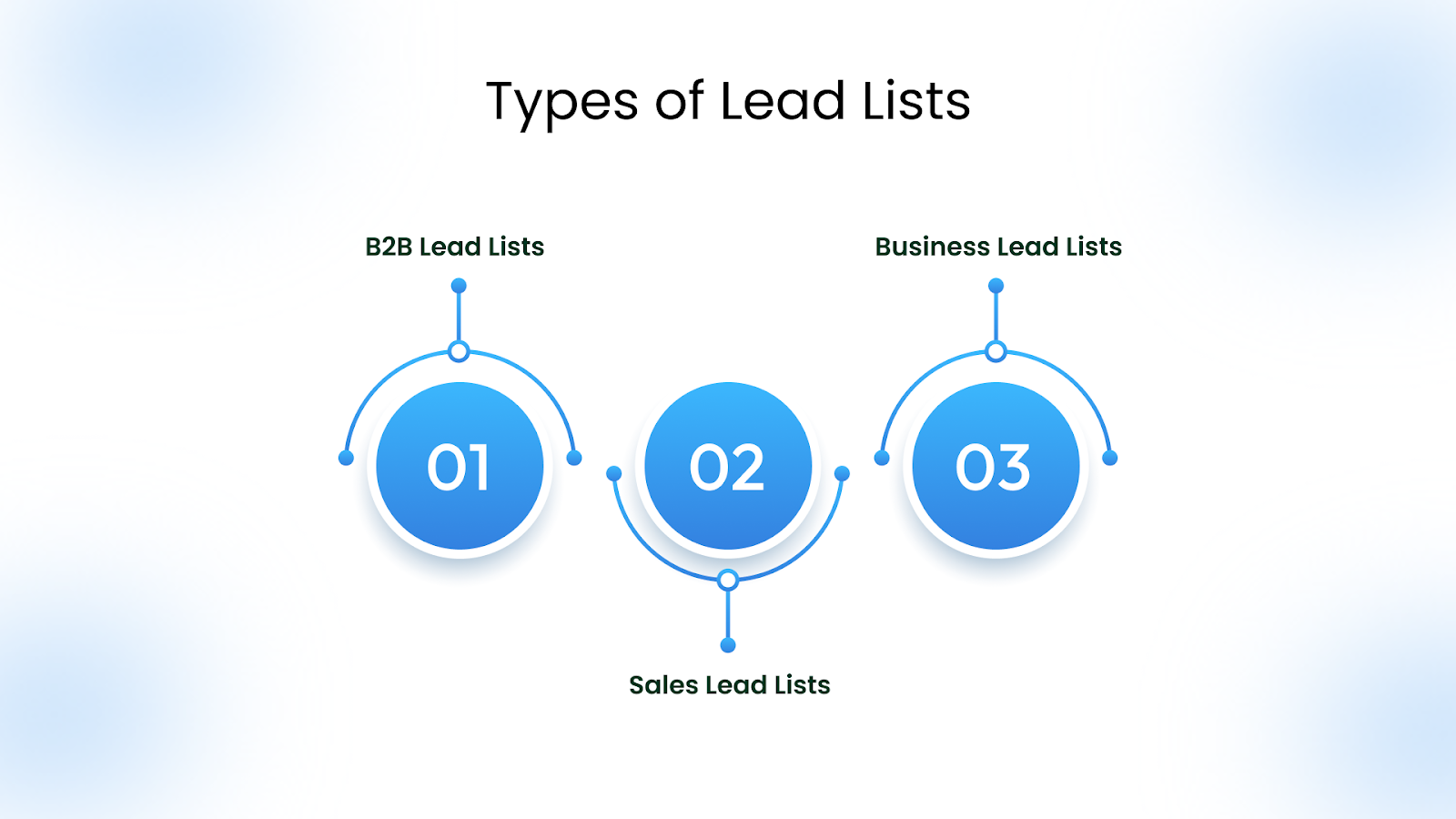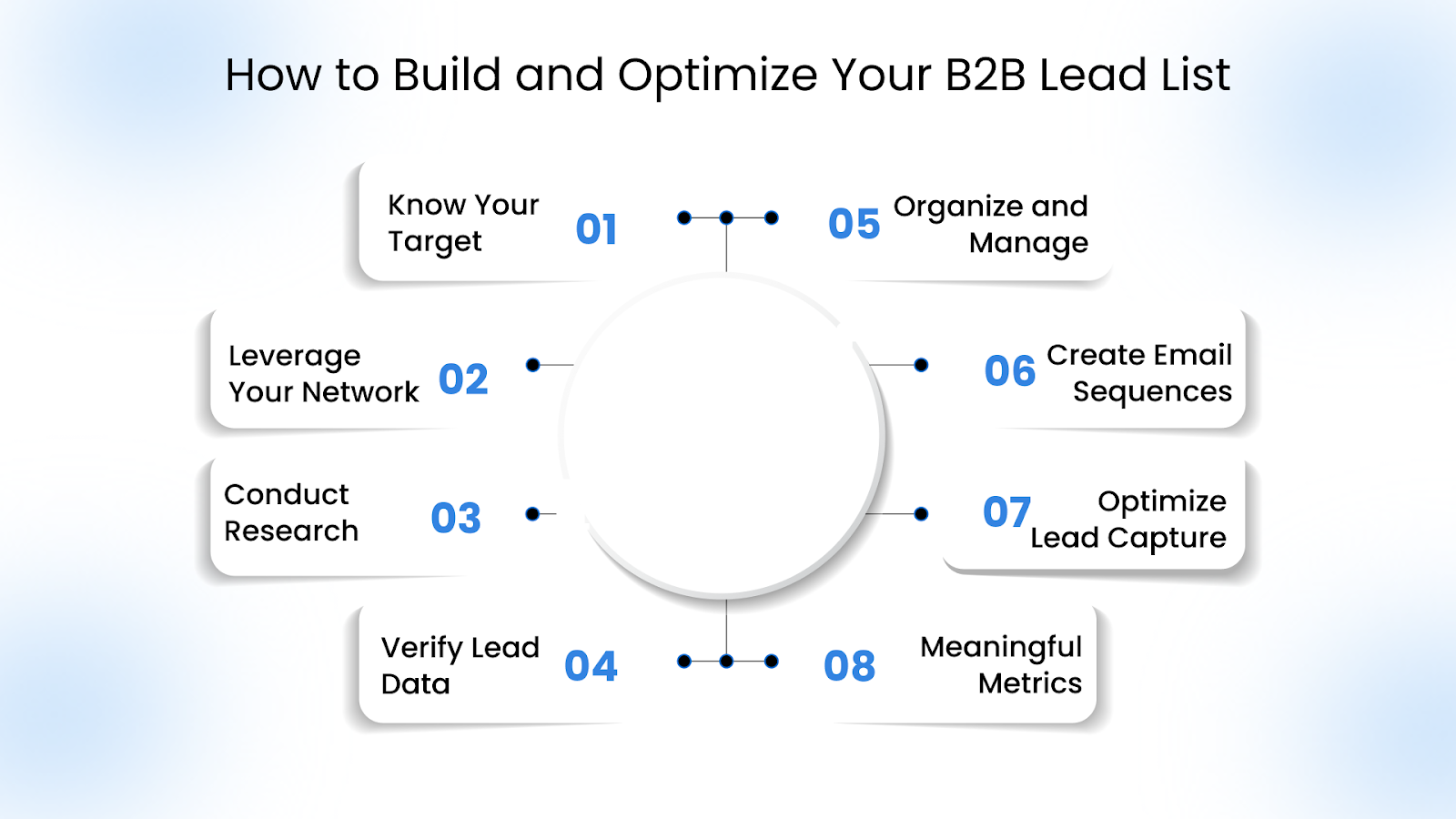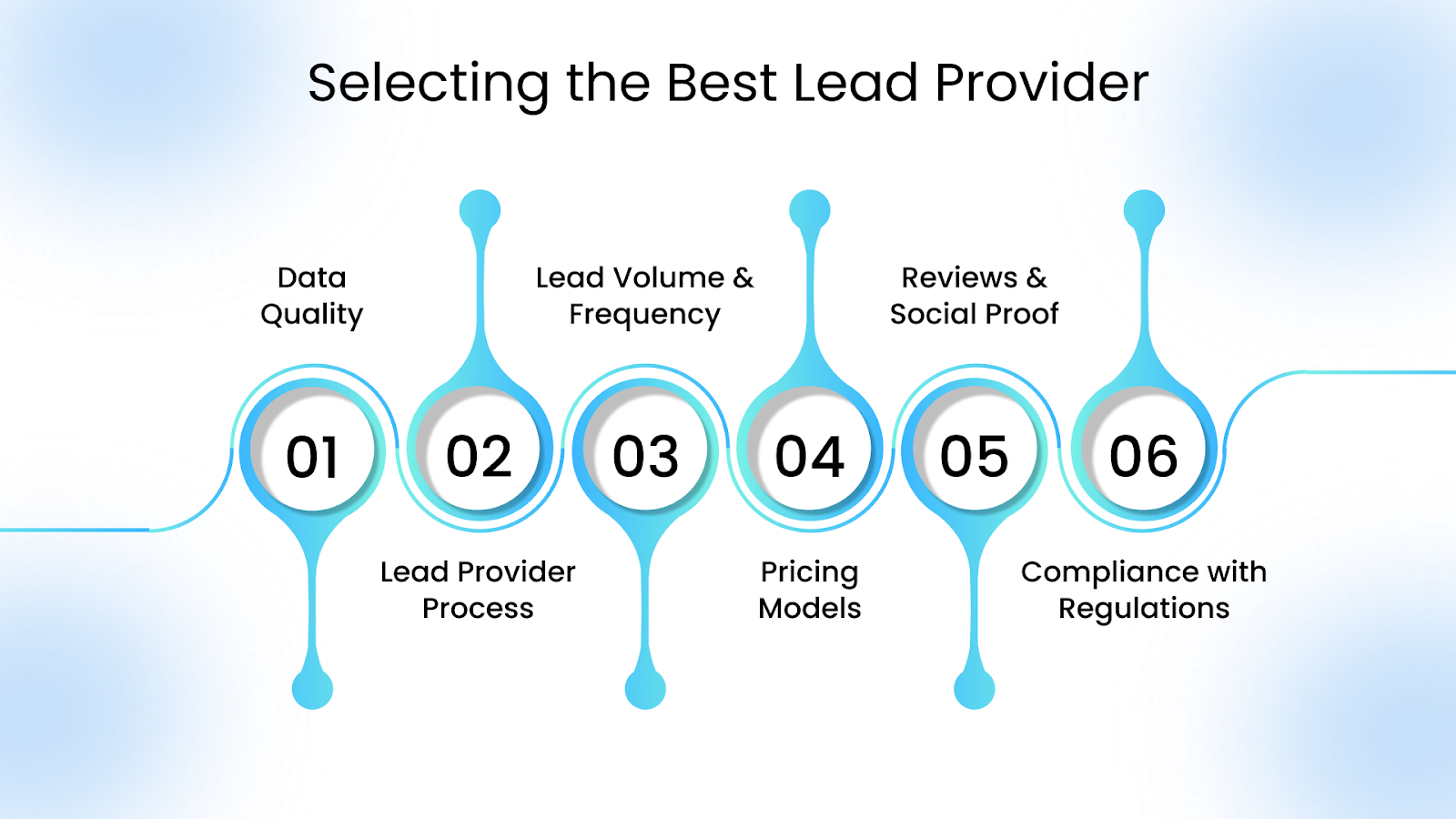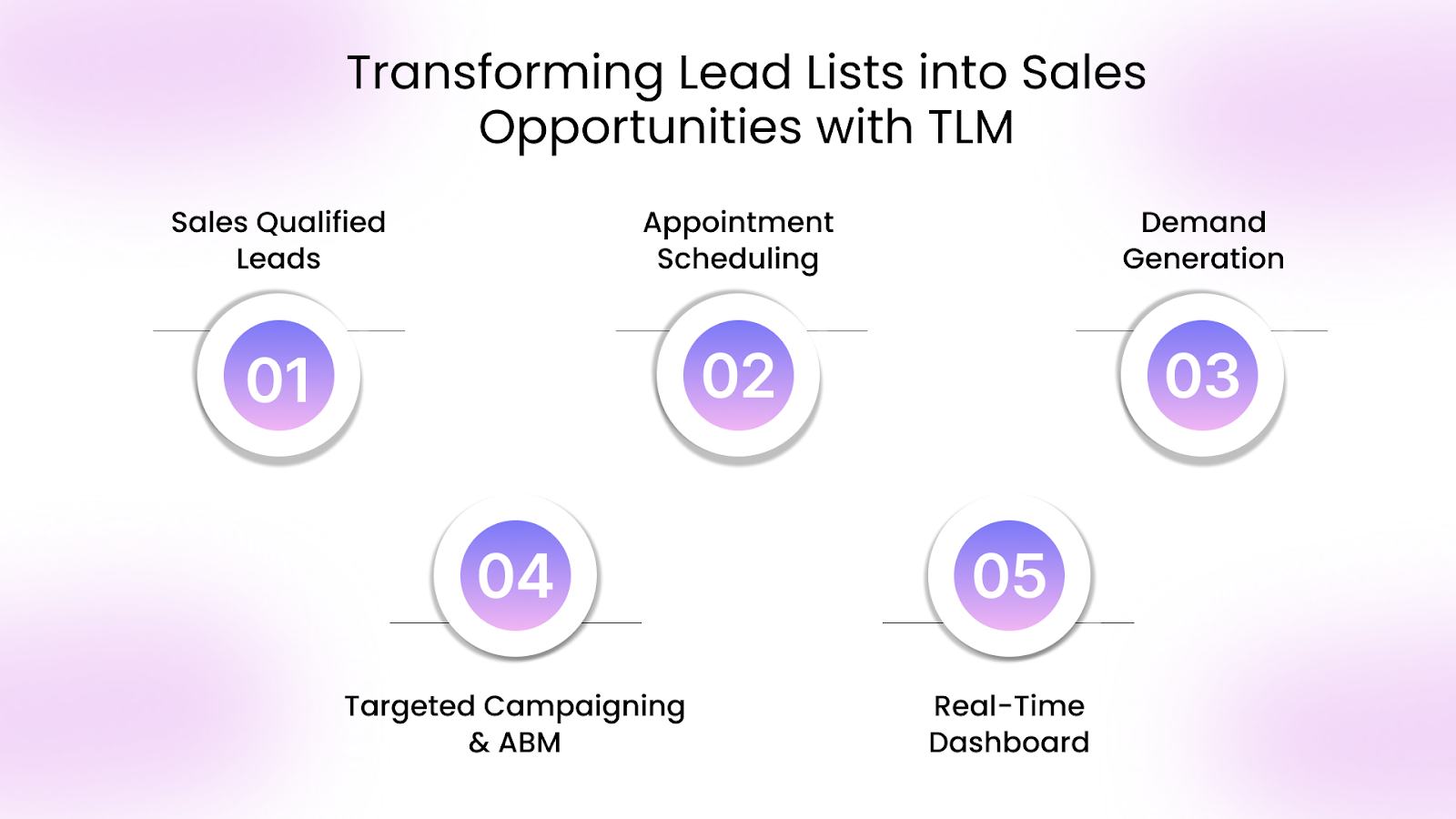
8-Step Guide to Building and Optimizing Lead Lists for Success

Are you still spending hours chasing leads that don’t move the needle? It’s frustrating when your team is bogged down by unqualified prospects, only to find themselves hitting dead ends. Every minute spent on leads that aren’t ready to convert is time you could’ve spent building relationships with those who are genuinely interested in your business.
In fact, 50% of marketers say that lead generation is their top priority in marketing campaigns. But here’s the catch: all those efforts are wasted without the right lead list. That means your approach needs to be more strategic, more precise, and laser-focused on the right prospects. That’s where building and optimizing your B2B lead list becomes essential.
A well-curated lead list allows your team to focus on high-potential prospects ready to engage. This blog will walk you through the process of building and optimizing a lead list that works for your B2B business.
We’ll explore the different types of lead lists, what they should include, and actionable steps to help you stop wasting time on leads that won’t convert and start focusing on those that truly matter, building a sales pipeline that’s primed for success.
Key Takeaways:
- Lead quality > lead quantity: Focus on high-potential prospects, not just filling the list.
- Know your buyer: Analyze your best customers to define who you should target next.
- Use your network: Referrals, existing clients, and LinkedIn can open powerful doors.
- Research smartly: Go beyond job titles, track buying signals, intent, and company context.
- Keep data clean: Verify emails, update details, and use sales triggers to time outreach.
- Segment & score: Organize leads based on fit, interest, and readiness to buy.
- Personalize your emails: Relevance + value + clear CTA = better engagement.
- Capture leads strategically: Use strong CTAs, forms, and incentives to grow your list.
- Outsource when needed: If time or bandwidth is a constraint, work with a reliable lead partner.
- Think long-term: A well-built lead list isn’t just a contact sheet—it’s your revenue foundation.
What is a Lead List?
A lead list is a curated collection of contact information for potential clients or prospects who are likely to be interested in your product or service. It’s the foundation of any successful B2B sales strategy, where reaching the right people at the right time can make all the difference.
A high-quality lead list enables sales teams to focus on the right prospects, optimizing their time and resources. It ensures that outreach efforts are aligned with business goals, increasing the chances of meaningful conversations and higher conversion rates.
But not all lead lists are the same. Let’s explore the different types of lead lists and how they can help fine-tune your strategy.
Types of Lead Lists

Building an effective lead list starts with understanding the types of leads you’re targeting. Whether you’re focusing on industry-specific prospects, geographic locations, or decision-makers, knowing the different types of lead lists will help you refine your outreach strategy. Here, we’ll break down the three main types of lead lists to help you optimize your lead generation process and drive better results.
1. B2B Lead Lists
B2B lead lists are typically industry-specific, targeting businesses that align with your company’s needs. These lists are designed to reach decision-makers in specific sectors, ensuring your outreach is directed to businesses that will benefit from your services.
These lists focus on specific industries, ensuring that your messaging is tailored to the needs and challenges of each sector. With B2B lead lists, your efforts are focused on companies that are most likely to need what you offer, improving your chances of successful outreach.
Many businesses, especially MSPs, spend time chasing unqualified leads, resulting in wasted efforts. TLM (The Lead Market) provides industry-specific B2B lead lists, combined with our proprietary tools like a real-time dashboard, SQL generation, and appointment scheduling. These ensure you’re targeting high-potential prospects and streamlining your outreach.
2. Sales Lead Lists
Sales lead lists are organized based on how ready a lead is to convert into a customer. These are divided into various categories:
- Cold Leads: These prospects have never heard of your company and require nurturing before they’re ready to engage.
- Warm Leads: These prospects have shown some interest but need further engagement before becoming a customer.
- Hot Leads: Prospects who are highly engaged and ready to make a purchase.
Understanding where your leads are in the sales cycle helps you craft personalized outreach that is more likely to convert.
3. Business Lead Lists
Business lead lists are centered around prospects who have interacted with your business somehow. These include:
- Referral Leads: Prospects referred by existing clients are often more likely to convert due to trust.
- Event Leads: Businesses that attended your events, showing a direct interest in your offerings.
- Inbound Leads: Prospects who have contacted you through your website or social media channels like LinkedIn indicate active interest in your services.
These lists ensure that your outreach is more targeted and personalized, increasing your chances of long-term relationships.
Understanding these three types of lead lists can help you create a highly targeted and effective outreach strategy. Now, let’s take a closer look at what a B2B lead list should look like and what key elements it should include to ensure its optimization for success.
The Key Components of a Successful Lead List
Building a successful lead list is about creating a well-organized, strategic list that aligns with your sales goals. A strong lead list can differentiate between hitting your sales targets and wasting time on unqualified prospects. Here's what your lead list should include to ensure it's primed for success.
- Full Name: The contact’s personal information is key for personalized outreach.
- Job Title: Knowing the role helps you target decision-makers with authority.
- Company Name: Identifying the business lets you tailor your outreach accordingly.
- Email Address: The primary contact method for cold email outreach.
- Phone Number: This can be useful for quick follow-ups.
- Industry: Helps align your messaging with the specific challenges of their sector.
- Company Size: Important for understanding the business context and how well they fit your ideal customer profile.
- Location: Geographic information ensures your outreach is relevant and
- Lead Source: Helps track the lead's origin, ensuring you optimize successful region-specific.
- Website: Provides insights into the business and its online presence.
With a well-structured lead list, your team can focus on high-value prospects that are ready to engage. But how do you collect that information? Let’s discuss the steps for building and optimizing your lead lists.
How to Build and Optimize Your B2B Lead List

An optimized B2B lead list is essential for ensuring your sales team focuses on high-potential prospects who are more likely to engage and convert. However many businesses struggle with the right strategy and approach to building a lead list that delivers results.
This section will summarize the essential steps to help you create and optimize your B2B lead list. By following these steps, you can build a lead list that drives higher conversions and long-term growth for your business.
1. Know Who You're Selling To
Every successful B2B lead list starts with clarity on who you're trying to reach. The more specific you are, the more relevant and effective your outreach becomes. Here’s how to define that clearly:
- Study Your Best Customers: Identify what your top clients have in common, industry, team size, location, roles, and recurring pain points.
- Focus on High-Value Segments: Prioritize industries and business types that benefit most from your offering.
- Refine by Size and Geography: Narrow down the market by company scale and regions that align with your solution.
- Identify Decision-Makers: Determine which roles are most involved in the buying process, founders, C-suite leaders, or functional heads.
- Analyze Competitors: See who they’re targeting, then find ways to stand out or tap into overlooked niches.
2. Utilize Your Existing Network
Your existing network is one of the most valuable resources when building a B2B lead list. These people already know your business and can refer you to relevant prospects.
Here’s how you can utilize your existing network to build your lead list:
- Reach out to current clients: Ask satisfied customers for referrals to similar businesses who might benefit from your services.
- Tap into your professional connections: Engage with your colleagues, partners, and industry peers to share leads and open new opportunities.
- Leverage social platforms: Use LinkedIn and other professional networks to see if any of your connections can introduce you to decision-makers in target industries.
- Ask for testimonials: Current clients who provide positive feedback will likely introduce you to others facing similar challenges.
3. Research and Identify Potential Leads
Now that you've utilized your existing network, it's time to expand your reach. Conducting thorough research is key to identifying prospects who match your Ideal Customer Profile (ICP).
Here’s how to research and identify potential leads:
- Use LinkedIn for lead searches: Search for leads based on industry, job title, and company size to narrow down your ideal prospects.
- Browse industry-specific directories: Explore business directories and trade publications for companies that fit your ICP.
- Leverage social media: Monitor Twitter, Facebook, and industry-specific forums to find businesses or decision-makers actively discussing your product or service.
- Use Google Alerts: Set up alerts for specific keywords relevant to your industry or product, and track companies that are engaging with those topics.
4. Verify Lead Data and Use Sales Triggers
Verifying the accuracy of your lead data is crucial for avoiding wasted outreach efforts and ensuring that you’re targeting the right people at the right time. Along with data verification, leveraging sales triggers is a smart way to increase the likelihood of engagement.
Here’s how to verify lead data and use sales triggers:
- Verify their email address: Sending out emails using an email management tool can help you confirm that email addresses are valid and active.
- Check company websites: Ensure your leads’ company information, such as size, location, and offerings, is up-to-date on their website.
- Look for sales triggers: Sales triggers, like hiring new executives or company expansions, signal the right time to engage.
5. Organize and Manage Your Lead List
After collecting your leads, the next step is to ensure they are organized and easily manageable. A cluttered lead list can quickly become overwhelming and inefficient. Organizing your lead list enables your sales team to find and act on valuable prospects quickly, boosting productivity and conversion rates.
Here’s how to organize and manage your lead list effectively:
- Categorize leads: Organize leads by industry, location, or interest level so your team can prioritize outreach based on relevance. Divide your leads into different target segments based on factors like sales readiness and buyer persona, tailoring your outreach to each group.
- Assign lead scores: Use a lead scoring system to rank leads based on their likelihood of conversion. This helps prioritize outreach to high-value prospects.
- Maintain up-to-date information: Regularly update your lead data, ensuring that all contact details and interactions are current.
6. Create Engaging Email Sequences
Creating compelling email sequences is essential for nurturing leads and keeping them engaged throughout their buying journey. A well-crafted email sequence informs prospects about your solution and builds trust, guiding them from initial interest to a conversion-ready state.
Here's how you can create engaging email sequences:
- Personalize each email: Reference the prospect’s previous interactions with your content or company, making the email feel relevant and tailored.
- Use compelling subject lines: Craft subject lines that grab attention and spark curiosity, increasing open rates.
- Focus on value: Each email should offer value, whether through educational content, a success story, or insights that help the prospect solve their challenges.
- Include a clear CTA: Ensure each email has a clear and actionable next step, whether it’s scheduling a call, downloading a resource, or requesting more information.
7. Optimize Lead Capture Efforts
Optimizing your lead capture efforts ensures you efficiently gather relevant lead data without frustrating potential prospects. Making this process as seamless as possible helps improve the chances of converting website visitors into leads and, eventually, customers.
Here’s how to optimize your lead capture efforts:
- Place clear CTAs on your website: Ensure call-to-action (CTA) buttons are prominently placed on your site, directing visitors to take the next step in their buyer journey.
- Use lead capture forms: Integrate forms for email subscriptions, free trials, or demo requests. Make the forms short and easy to complete to avoid overwhelming prospects.
- Offer incentives: Provide valuable offers, like discounts, consultations, or free resources, in exchange for lead information to encourage sign-ups.
- Utilize exit-intent pop-ups: When a visitor is about to leave your site, trigger an exit-intent pop-up offering a special discount or valuable resource to capture their information before they go.
8. Update and Maintain Your Lead List Regularly
Over time, contact information changes, and leads may no longer be a good fit for your business. Regularly maintaining and updating your lead list will help you stay on top of your sales efforts and avoid wasted outreach.
Here’s how to update and maintain your lead list regularly:
- Remove outdated leads: Periodically check and remove leads that are no longer relevant, such as unresponsive or inactive contacts.
- Update contact details: Ensure that all lead information, including email addresses, phone numbers, and job titles, is up-to-date.
- Review lead scoring: Re-evaluate and adjust your lead scores based on new data or changes in your lead’s activity or engagement.
- Monitor lead activity: Regularly check how your leads engage with your outreach efforts. Update the list to prioritize leads showing high interest.
- Add new leads: Consistently add new leads to your list through referrals, events, or research. Keep your list growing and evolving.
If this process feels overwhelming and you lack the time, patience, or resources to manage it effectively, there’s a better approach: outsourcing the lead list generation. Let’s understand when it makes sense to consider this option.
Also read: How to Build Effective B2B Email Lists
Why Should You Consider Outsourcing B2B Lead List Generation?

Building an effective B2B lead list is a time-consuming and resource-intensive process that requires strategy, research, and consistent effort. Outsourcing lead list generation can be a smart choice for many businesses, especially those with limited time, resources, or expertise.
By working with a trusted lead provider, you can skip the hassle of building lists from scratch and focus on what really matters: closing deals and growing your business. Here are some situations when outsourcing B2B lead list generation is a smart move:
- Lack of Time and Resources: If your team is already stretched thin, outsourcing allows you to leverage the expertise of a lead provider, saving you valuable time and energy.
- Rapid Growth and Scalability: If your business is expanding quickly and needs to scale your lead generation efforts, outsourcing helps you meet demand without slowing down growth.
- Launching New Products or Services: Your old lead lists may not be enough when introducing new offerings. Outsourcing allows you to quickly build fresh, relevant leads to support your sales strategy.
- Empty Sales Pipeline: If your sales pipeline is running dry and you need an influx of qualified prospects, outsourcing lead generation can immediately fill the gap, providing you with high-potential leads ready for outreach.
- Expertise in Targeting: Outsourcing gives you access to industry-specific lead lists tailored to your needs. Professional lead providers specialize in generating highly relevant leads, ensuring you’re reaching the right decision-makers.
- Improved Data Accuracy: Lead providers ensure that the data they offer is accurate and up-to-date, saving you the effort of constantly validating contact information and reducing wasted outreach.
For example, a California-based MSP franchise partnered with TLM (The Lead Market) to overcome ineffective and costly lead generation challenges. They struggled to find high-quality leads and didn’t have the option to select which leads they wanted to pay for.
By working with TLM, they narrowed their focus to local businesses with 10+ employees, targeting the right decision-makers in the IT industry. After just one month, they saw 11 qualified leads and were able to choose which leads they wanted to pay for—a capability they never had with their previous vendors.
Today, TLM’s tailored B2B lead generation and appointment setting process supports over 100 locations of the client’s nationwide franchise network, generating consistent, high-quality leads each month.
This case study showcases how outsourcing with the right partner can work wonders for your business. But how do we find the right partner? Let’s dive into the criteria for it.
Selecting the Best Lead Provider: What You Need to Know

Choosing the right lead provider can significantly impact your sales pipeline and overall business growth. But how do you ensure you're selecting the best one? Here’s what you need to consider.
1. Review the Lead Provider’s Data Quality
Data quality is paramount when selecting a lead provider. Ensure that your purchasing leads are accurate, relevant, and up-to-date. Old or incorrect leads can waste your time and resources, resulting in low engagement rates and missed opportunities.
- Verify Data Accuracy: Ask how the provider verifies and updates their data.
- Ensure Lead Relevance: Confirm that the leads match your ideal customer profile (ICP).
- Check for Transparency: The provider should clearly explain how they source their data and keep it current.
2. Understand the Lead Provider’s Process
A reputable lead provider should be transparent about its lead generation process. This ensures that you know exactly what you’re paying for and how the leads are collected. Look for a provider who is upfront about its methodology and results.
- Ask About Lead Sourcing: Find out how they collect and qualify leads.
- Evaluate Their Methodology: Ensure their process aligns with your sales goals and strategies.
- Request Case Studies or Testimonials: These should demonstrate their ability to generate results for similar businesses.
3. Consider the Volume and Frequency of Leads
The number of leads you need depends on your business model and sales goals. Some businesses require a steady stream of leads every month, while others may need leads on a more ad-hoc basis. Make sure the provider can offer a lead generation plan that fits your needs.
- Determine Lead Volume: Decide how many leads you require and whether the provider can consistently meet that volume.
- Check for Flexibility: Make sure they offer lead generation options that are scalable and adjustable.
4. Compare Pricing Models
It’s important to understand the lead provider's pricing structure. Some charge per lead, while others offer monthly retainers. Compare the costs and determine which model fits your business needs and budget.
- Understand Their Pricing: Ensure the pricing model aligns with your budget and goals.
- Look for Value: Consider the quality of the leads relative to their cost.
- Consider Long-Term Costs: Ensure you’re not just paying for leads but for a strategy that will build your sales pipeline over time.
At TLM, we understand that every business is unique. That’s why we offer flexible pricing models, including a 2-month pilot, after pilot, and a customized Enterprise pricing model designed to suit your specific needs. Explore Our B2B Lead Generation Services and discover how TLM’s tailored pricing can work for you.
5. Check Reviews and Social Proof
Before committing to a provider, do your homework. Look for reviews, testimonials, or case studies that validate the provider's claims. This will give you confidence that the leads they deliver are effective and beneficial to your business.
- Assess Their Reputation: A strong reputation indicates reliability and effective lead generation practices.
- Look for Social Proof: Check review sites like Capterra or G2, or for feedback from other businesses. For instance, TLM’s G2 profile has five-star ratings with reviews like “The Lead Market is a true partner and understands the size and type of business we are looking for, which limits our time qualifying leads and allows for a smooth sales process.”
6. Ensure Compliance with Regulations
Lead generation involves handling sensitive customer data. Make sure that your provider follows industry regulations such as the CAN-SPAM Act for email marketing. Compliance is crucial to maintaining customer trust and avoiding legal issues.
- Verify Data Protection Practices: Ensure they follow the CAN-SPAM Act for email communications.
- Check for Privacy Policies: A reputable provider will have clear data privacy policies.
Choosing the best lead provider can make all the difference in optimizing your lead generation efforts. Once you have a reliable partner, you can save valuable time and focus on converting high-quality leads into long-term customers.
Transforming Lead Lists into Sales Opportunities with TLM (The Lead Market)

At TLM, we specialize in turning targeted lead lists into real, revenue-driving opportunities. Our tailored approach ensures that your sales team engages with only the most qualified leads, optimizing the entire sales pipeline and ensuring a higher chance of conversion. Here’s what we provide:
- Sales Qualified Leads (SQL): TLM provides sales-ready leads that perfectly align with your business goals, boosting conversion rates.
- Appointment Scheduling: We take the burden off your team by scheduling meetings with qualified leads, ensuring that your sales reps spend their time closing deals rather than chasing leads.
- Demand Generation: Our multi-channel strategies engage prospects and keep them interested, nurturing them until they are ready to convert.
- Targeted Campaigning & ABM: TLM creates highly personalized campaigns targeting high-value accounts, ensuring messaging resonates with decision-makers and driving higher conversion rates.
- Real-Time Dashboard: Our proprietary tools offer actionable insights, making it easier for you to optimize communication, follow-up strategies, and lead management.
At TLM, we don’t just generate leads; we focus on transforming those leads into real sales opportunities. With our proven track record, especially with MSPs across North America, Australia, and Canada, we help businesses like yours streamline lead generation efforts and maximize MRR.
FAQs
1. What are lead lists?
Lead lists are curated databases of potential customers, containing details like names, job titles, emails, phone numbers, and company info. They’re used to target the right audience for outreach, sales, or marketing campaigns.
2. Where can I get lead lists?
You can source lead lists by researching publicly available business data, exploring professional networks, or collecting leads through your inbound channels. Companies like TLM (The Lead Market) can also help streamline the process of lead discovery and qualification.
3. How do I create a lead list?
To build your own lead list:
- Define your ideal customer profile (ICP)
- Research contacts using LinkedIn, company sites, or lead gen tools
- Use enrichment tools to add missing data
- Verify email addresses and contact info before outreach
Focus on accuracy and relevance to get better results.






